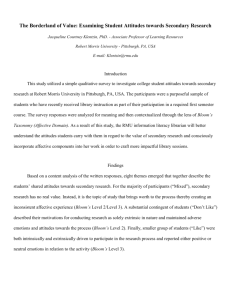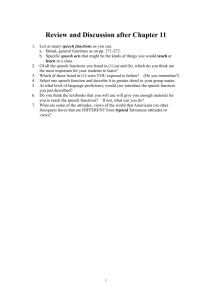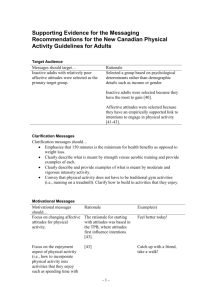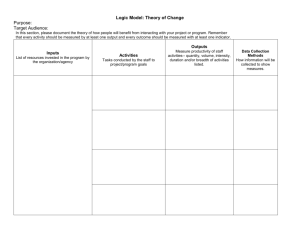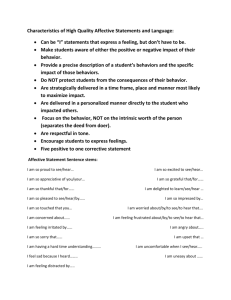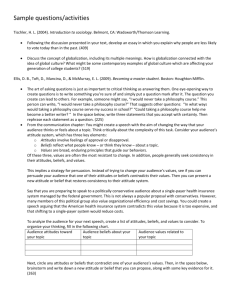Science for Life - development of a multi
advertisement
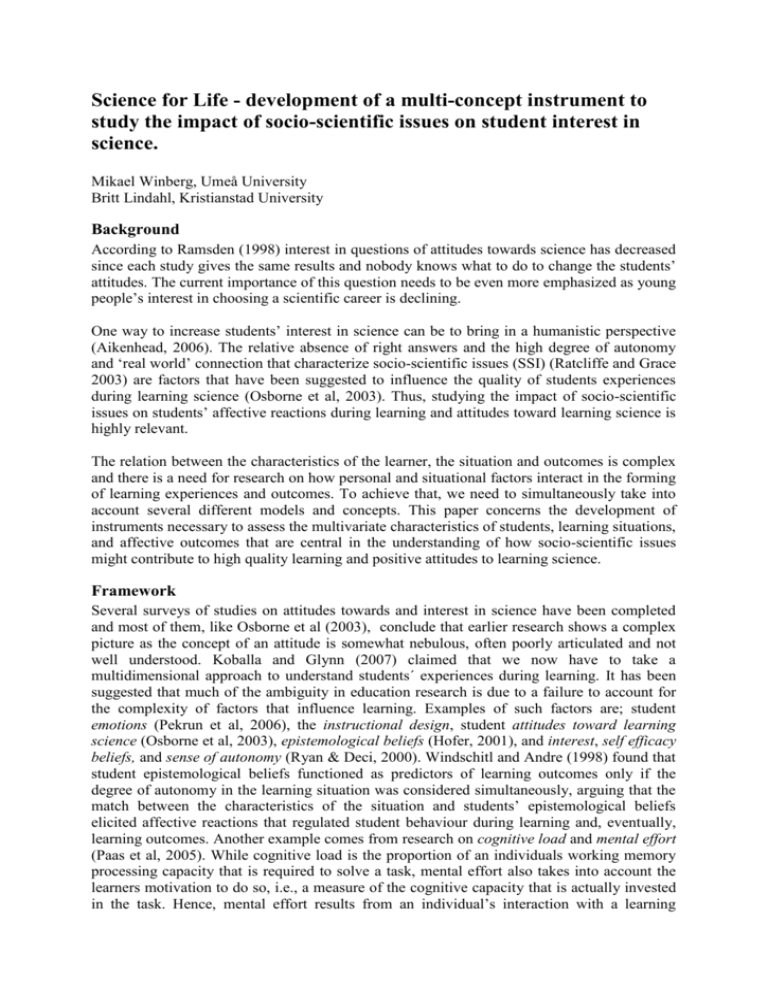
Science for Life - development of a multi-concept instrument to study the impact of socio-scientific issues on student interest in science. Mikael Winberg, Umeå University Britt Lindahl, Kristianstad University Background According to Ramsden (1998) interest in questions of attitudes towards science has decreased since each study gives the same results and nobody knows what to do to change the students’ attitudes. The current importance of this question needs to be even more emphasized as young people’s interest in choosing a scientific career is declining. One way to increase students’ interest in science can be to bring in a humanistic perspective (Aikenhead, 2006). The relative absence of right answers and the high degree of autonomy and ‘real world’ connection that characterize socio-scientific issues (SSI) (Ratcliffe and Grace 2003) are factors that have been suggested to influence the quality of students experiences during learning science (Osborne et al, 2003). Thus, studying the impact of socio-scientific issues on students’ affective reactions during learning and attitudes toward learning science is highly relevant. The relation between the characteristics of the learner, the situation and outcomes is complex and there is a need for research on how personal and situational factors interact in the forming of learning experiences and outcomes. To achieve that, we need to simultaneously take into account several different models and concepts. This paper concerns the development of instruments necessary to assess the multivariate characteristics of students, learning situations, and affective outcomes that are central in the understanding of how socio-scientific issues might contribute to high quality learning and positive attitudes to learning science. Framework Several surveys of studies on attitudes towards and interest in science have been completed and most of them, like Osborne et al (2003), conclude that earlier research shows a complex picture as the concept of an attitude is somewhat nebulous, often poorly articulated and not well understood. Koballa and Glynn (2007) claimed that we now have to take a multidimensional approach to understand students´ experiences during learning. It has been suggested that much of the ambiguity in education research is due to a failure to account for the complexity of factors that influence learning. Examples of such factors are; student emotions (Pekrun et al, 2006), the instructional design, student attitudes toward learning science (Osborne et al, 2003), epistemological beliefs (Hofer, 2001), and interest, self efficacy beliefs, and sense of autonomy (Ryan & Deci, 2000). Windschitl and Andre (1998) found that student epistemological beliefs functioned as predictors of learning outcomes only if the degree of autonomy in the learning situation was considered simultaneously, arguing that the match between the characteristics of the situation and students’ epistemological beliefs elicited affective reactions that regulated student behaviour during learning and, eventually, learning outcomes. Another example comes from research on cognitive load and mental effort (Paas et al, 2005). While cognitive load is the proportion of an individuals working memory processing capacity that is required to solve a task, mental effort also takes into account the learners motivation to do so, i.e., a measure of the cognitive capacity that is actually invested in the task. Hence, mental effort results from an individual’s interaction with a learning situation and reflects the learner’s knowledge in the domain, his/her motivation to engage in the task (influenced by task value and complexity, self efficacy and sense of autonomy) and, at least in the case of more ill defined tasks, how the task is interpreted (involving the pupil’s epistemological beliefs). If the complexity of the task is too high in relation to the learner’s prior knowledge, effective processing of the information is hampered, ultimately affecting the learner’s ability to solve the task - and the affective experiences during learning. Aims The aim is to develop an instrument that simultaneously considers the characteristics of the student, situation, and outcomes. We want to investigate this instrument’s ability to indicate which personal and/or situational characteristics are the most important to describe variation in student behaviour during learning as well as affective and perceived cognitive outcomes. Method/Results Construction and categorization of items A large number of items were collected from extant questionnaires and, when necessary, adapted to Swedish conditions. Additional items were constructed, based on theory within the relevant fields of research. Items were categorized through Principal Component Analysis (PCA) of 1276 responses to the questionnaire, paralleled by discussions between researchers. The final categories, and the descriptive (R2) and predictive (Q2) ability of the PCA models describing the categories, are found in table 1. Table 1. The categories, the contextual aspects they relate to (Personal, Situational, and Outcome), and number of components and statistical performance of the corresponding PCA model. 1 2 3 4 5 6 7 Categories Items Attitudes and goals (P) Beliefs about learning (P) Self-efficacy / locus of control (P) Ordinary work forms (P) Work forms during SSI-work (S) Affective outcomes (O) Cognitive outcomes (O) 43 20 16 7 17 19 11 Comp. 3 1 2 2 3 1 1 R2 (%) Q2 (%) 39 23 55 45 40 38 33 28 14 39 -6 3.8 31 20 All models showed intelligible distribution of items on the different components (describing the underlying “features” that connect items to each other) and correlation patterns.. The descriptive and predictive ability ranged from moderate to good, with the exception of the “work form”- models that had poor predictive ability – possibly indicating the lack of an underlying construct that link the different work forms. Prediction Model The large number of variables, although improving reliability of the instrument, makes interpretation of the relations between them difficult. Therefore, hierarchical PLS analysis was applied to items in categories 1-5 respectively to investigate their relation to outcomes and to “condense” items (i.e., personal and situational characteristics) into latent components. Then the latent components from all categories were pooled and their relations to affective and cognitive outcomes were examined in a “top model”. Table 2 shows number of components and performance of the PLS models on separate categories and the top model. Table 2. Number of condensed variables in each category, percentage of described variation in the independent variables (R2X) and outcomes (R2Y), and predictive ability (Q2) of models Category 1 2 3 4 5 Attitudes and Goals Beliefs about learning and knowledge Self-efficacy / locus of control Ordinary work forms in science class Work forms during SSI-work Comp. R2 X R2 Y Q2 2 1 2 1 2 28 22 50 29 36 43 16 25 6 44 37 14 22 4 38 2 47 56 56 Top model Components from category 1-5 vs. outcomes The single categories “Attitudes and Goals” and “Work forms during SSI work” seems useful for predicting outcomes. However, the top model that includes components from all categories is better at describing and predicting variation in outcomes than any singlecategory model, which supports the idea that we need to consider several variables simultaneously. Response permutation testing, and external dataset validation of the top model supports its validity (data not shown). Details on the validation process and the specific original variables that were most influential in the prediction of affective and perceived cognitive outcomes are available and will be reported on the conference. Conclusions and Implications Initial PCA models (table 1) support the categorisation of items. The top model was able to indicate the relative impact of the categories on cognitive and affective outcomes (figure not shown). Most categories contributed, although in varying degree, to the predictive ability of the top model, supporting the validity of the multivariate approach. Although there is a need for a more in-depth investigation of patterns of causality (to be performed within the project during 2008), the potential implications of a deeper understanding of these relations are obvious for everyone interested in instructional design. Bibliography Aikenhead (2006). Science Education for Everyday Life: Evidence-Based Practice. New York: Teachers College Press. Hofer (2001). Personal epistemology research: implications for learning and teaching. Journal of Educational Psychology review, 13(4), 353-383. Kobala & Glynn (2007). Attitudinal and Motivational Constructs in Science Learning. In Abell & Lederman (Eds.). Handbook of Research on Science Education. Mahwah, New Jersey: LEA Publishers. Osborne, Simon, & Collins, (2003). Attitudes towards science: a review of the literature and its implications. International Journal of Science Education, 25(9), 1049-1079. Paas, Tuovinen, van Merriënboer & Darabi, (2005). A Motivational Perspective on the Relation Between Mental Effort and Performance: Optimizing Learner Involvement in Instruction. . Educational Technology Research & Development, 53(3), 25-34. Pekrun, Elliot, & Maier (2006). Achievement goals and discrete achievement emotions: A theorethical model and prospective test. Journal of Educational Psychology, 98(3), 583-597. Ramsden (1998). Mission impossible?: Can anything be done about attitudes to science? International Journal of Science Education, 20(2), 125-137. Ratcliffe & Grace (2003). Science Education for Citizenship. Teaching Socio-Scientific Issues. Maidenhead: Open University Press. Ryan & Deci (2000). Intrinsic and Extrinsic Motivations: Classic Definitions and New Directions. Contemporary Educational Psychology, 25(1), 54-67. Windschitl & Andre (1998). Using computer simulations to enhance conceptual change: The roles of constructivist instruction and student epistemological beliefs. Journal of research in science teaching, 35(2), 145-160.

